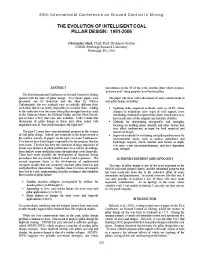Mining Publication: The Evolution of Intelligent Coal Pillar Design: 1981-2006
Original creation date: August 2006
The first International Conference on Ground Control in Mining opened with the topic of pillar design. Two classic papers were presented, one by Bieniwski and the other by Wilson. Unfortunately, the two methods were so radically different from each other that it was nearly impossible to reconcile them. Adding to the confusion were the many other pillar strength formulas (such as the Salamon-Munro, the Holland-Gaddy, and the Obert-Duvall, just to name a few) that were also available. Little wonder that discussions of pillar design in those days often ended with anguished cries of "but which formula is the right one? The past 25 years have seen substantial progress in the science of coal pillar design. Indeed, one testament to the improvement is the relative scarcity of papers on the topic at recent Conferences. Two factors have been largely responsible for the progress that has been made. The first has been the collection of large data bases of actual case histories of pillar performance in a variety of settings, from shallow room-and-pillar mines through deep cover longwalls. These have made possible the development of empirical design procedures that are closely linked to real world experience. The second important factor is the development of sophisticated computer models that can accurately simulate pillar behavior and roof/pillar/floor interactions. Together, these two lines of research have led to a new understanding of pillar mechanics that identifies three modes of pillar failure: Sudden, massive collapse, accompanied by airblast, for slender pillars (width/height<4). Squeezing, or slow, non-violent failure, for most room and pillar applications (410). It is particularly satisfying that the insights gained from numerical models broadly support those obtained from the empirical studies. While far less controversial than in the past, pillar design problems continue to arise. One recent example is pillar design for highwall mining. NIOSH has just released a software package, called ARMPS-HWM, which employs a number of modern pillar design concepts. Since highwall mining web pillars are long and slender, the greatest danger is that of a sudden collapse. ARMPS-HWM suggests two possible prevention strategies, one which concentrates on the SF of the webs, and the other which creates a "pressure arch" using properly sized barrier pillars. The paper will close with a discussion of some current needs in coal pillar design, including: Updating older empirical methods, such as ALPS, where changes in technology (new types of roof support, more demanding ventilation requirements, faster retreat rates) may have made some of the original case histories obsolete. Methods for determining site-specific coal strengths, focusing on bedding plane strength and other factors that may effect confinement, as input for both empirical and numerical design. Improved methods for evaluating coal pillar performance for environmental issues, such as surface subsidence and hydrologic impacts, which consider such factors as depth, w/h ratio, water immersion/drainage, and time dependent seam strength.
Authors: C Mark
Conference Paper - August 2006
NIOSHTIC2 Number: 20030828
Proceedings of 25th International Conference on Ground Control in Mining, August 1-3, 2006, Morgantown, West Virginia. Peng SS, Mark C, Finfinger G, Tadolini S, Khair AW, Heasley K, Luo Y, eds., Morgantown, WV: West Virginia University, 2006 Aug; :325-334
See Also
- Analysis of Multiple Seam Stability
- Degasification System Selection for U.S. Longwall Mines Using an Expert Classification System
- Effects of Weak Bands on Pillar Stability in Stone Mines: Field Observations and Numerical Model Assessment
- Elastic and Shear Moduli of Coal Measure Rocks Derived from Basic Well Logs Using Fractal Statistics and Radial Basis Functions
- Pillar Strength and Design Methodology for Stone Mines
- Simplified Pre- and Post-Processing Technique for Performing Finite-Element Analyses of Deep Underground Mines
- The State-of-the-Art in Coal Pillar Design
- Stochastic Modeling of Gob Gas Venthole Production Performances in Active and Completed Longwall Panels of Coal Mines
- Task Analysis
- Technology News 516 - ARMPS-HWM: New Software for Sizing Pillars for Highwall Mining
- Page last reviewed: 9/21/2012
- Page last updated: 9/21/2012
- Content source: National Institute for Occupational Safety and Health, Mining Program


 ShareCompartir
ShareCompartir
